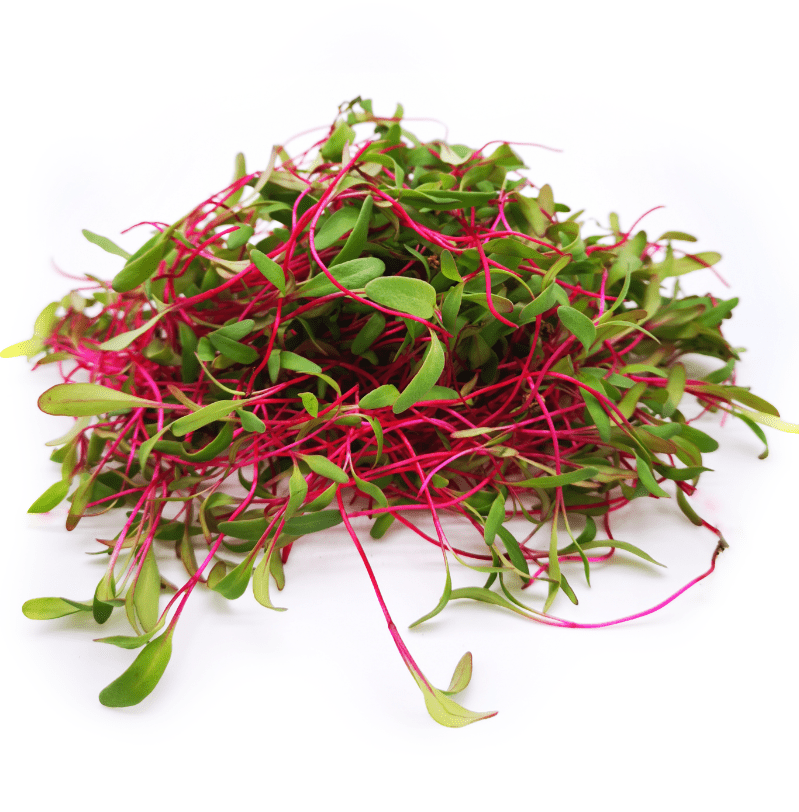All of you may or may not have heard about beetroots and their numerous benefits, but have you heard about the beet microgreen? If not, then you’re in luck, because in this article, I’ll be talking about beet microgreens, how to grow beet microgreens, the benefits of beet microgreens, and much more. And most importantly, whether or not the beet microgreen is the same as the beetroot?
How To Grow Beet Microgreens
To grow beet microgreens, you will need a container with drainage holes, potting soil, and beet seeds. Fill the container with potting soil, and then sprinkle the beet seeds on top.
Gently press the seeds into the soil, and then water them well. Place the container in a bright spot, and keep the soil moist but not wet. The microgreens will be ready to harvest in about two weeks. To harvest, simply cut the greens at the base with a sharp knife. Enjoy your fresh beet microgreens as a salad topping or in a sandwich. They are also a great way to add some extra nutrition to your smoothies or juices.
I’ve discussed the process of how to grow beet microgreens, let me now talk about it in more detail.

How To Grow Beet Microgreens
Step-by-Step Guide
Microgreens are extremely easy to grow, and beets are no exception. With just a few simple supplies, you can harvest a fresh crop of these nutrient-packed greens in as little as two weeks. Here’s everything you need to know to get started.
First, purchase some beet seeds from your local nursery or online retailer. Then, fill a shallow tray with potting mix or seed-starting mix and moisten it thoroughly. Next, sow the seeds evenly across the surface of the soil, and cover them with another layer of mix. To keep the seeds moist, place the tray in a warm, sunny spot and mist it regularly with water. Within a week or two, you should see sprouts emerging. Once the sprouts are about an inch tall, thin them out so that they’re spaced about an inch apart. Continue to water the tray regularly and mist it as needed.
In another week or two, your microgreens will be ready to harvest. Simply snip them off at the base with sharp scissors and enjoy!
Now that you know how to grow beet microgreens, let’s talk about another aspect of this delicacy, shall I?
What Is The Beet Microgreen?
Beet microgreens are a type of edible green that is harvested from beet plants. Beet microgreens are typically harvested 7-14 days after the seedlings have emerged. These microgreens have a sweet, earthy flavor and are rich in vitamins and minerals. Beet microgreens can be used in salads, sandwiches, soups, and other dishes. They can also be juiced or blended into smoothies. Beet microgreens are a nutritious and versatile addition to any diet.
Is The Beet Microgreen Related To The Beet Root?
The beet microgreen is not related to the beetroot. The beet microgreen is the sprouted greens of the beetroot plant and has a similar taste to spinach. They are a source of vitamins A, C, and K, and also contain potassium, magnesium, iron, and calcium.
Beet microgreens are often used as a garnish or as an ingredient in salads. The beetroot plant is a member of the Chenopodiaceae family, which includes other leafy vegetables such as spinach, kale, and Swiss chard. The beetroot is the edible root of the plant and is typically red or purple in color. It is a source of vitamins A, B6, and C, as well as minerals such as potassium and iron. The beetroot can be eaten raw, cooked, or pickled. It is also often used as an ingredient in soups and salads.
Health Benefits Of The Beet Microgreen
Beet microgreens are a nutrient powerhouse, providing high levels of vitamins A, C, and K, as well as important minerals like iron and magnesium. They’re also a good source of fiber and antioxidants. While all of these nutrients are important for overall health, they may offer some specific benefits as well.

For example, vitamin C in beet microgreens can help to boost immunity, while iron content may help to prevent anemia. The fiber in beets can also help to promote gut health, and the antioxidants may help to protect against some chronic diseases. Overall, consuming beet microgreens on a regular basis is a great way to support your overall health.
Best Dishes To Enjoy The Beet Microgreen
Beet microgreens have a slightly sweet and earthy flavor that pairs well with other milder greens in salads, or with fruits and nuts in a more punchy salad. They’re also lovely as a garnish on grilled fish or chicken, adding both pretty color and flavor. One of our favorite ways to use beet microgreens is in this Beet Carpaccio with Goat Cheese and Pistachios: thinly slice a raw beet (we like Chioggia beets for their candy-stripe interior) on a mandoline or with a very sharp knife, then top with crumbled goat cheese, chopped pistachios, and a drizzle of olive oil. So easy, so elegant.
Another great way to show off these pretty microgreens is in our Tartine with roasted sweet potatoes, radicchio, and beet microgreens. If you can’t find radicchio, feel free to substitute another slightly bitter green like frisée or dandelion greens. beet carpaccio, goat cheese, pistachios, olive oil, sweet potatoes, radicchio, beet microgreens, frisée, dandelion greens
You can also use beet microgreens as a colorful and flavorful addition to smoothies or juices. Simply add a handful to your favorite recipe, or try our Beet, Berry, and Ginger Smoothie: combine 1 cup frozen mixed berries, 1 small roasted beet ( peeled and chopped), 1-inch piece of fresh ginger (peeled and chopped), 1 cup almond milk, and 1 tablespoon honey in a blender and blend until smooth.
Beet microgreens are a delicious and nutritious way to add color and flavor to any dish. With their sweet, earthy flavor and nutrient-rich profile, these microgreens are a welcome addition to any diet.
Conclusion
In conclusion, to grow beet microgreens, start by soaking the seeds in water for 24 hours. Then, drain the seeds and spread them evenly on a moistened paper towel. Roll up the paper towel, and place it in a plastic bag. Store the bag in a cool, dark place for 3-5 days, until the seeds have germinated. Once the seeds have germinated, transplant them into the soil or a growing medium. Water the microgreens regularly, and harvest them when they are 2-3 inches tall. Enjoy your fresh, nutritious beet microgreens!
I hope your knowledge of how to grow beet microgreens has increased.

